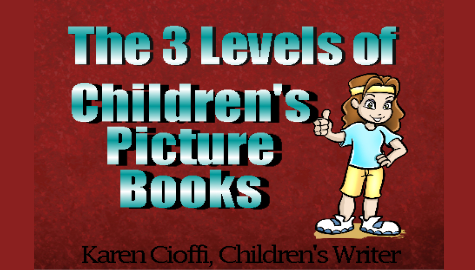
Children’s picture books have 3 levels or purposes regarding the reader and the purchaser. Think of it as the structure of a house: there’s a basement, a first floor, and often an upper floor.
Level 1: The basement, or Surface Level, is geared toward the youngest reader (or listener if too young to read). This child is able to understand what’s going on. He is engaged by the story. Using the wonderful children’s picture book “Caps For Sale” by Esphyr Slobodkina, the child will think it’s funny that the monkeys take the peddler’s caps, put them on their heads and won’t take them off.
Level 2: The first floor, or the Underlying Meaning Level, is for the older children who can understand on a deeper level. At this age, they can recognize danger, anger, and cause-and-effect scenarios. Again, using “Caps for Sale,” the children should be able to understand that the monkeys are mimicking everything the peddler does, but the peddler doesn’t realize what they’re doing. The child may yell out, “They’re doing what you do!” in an effort to help the peddler.
Level 3: The upper floor, or the Take Away Level, is the value the book holds for the purchaser, usually the parent, grandparent, or teacher. The adult reading the book to the child understands the story’s meaning and what value can be taken away by children. In “Caps for Sale,” the child is engaged and understands that the monkeys took the peddler’s caps and won’t give them back. The older child is involved and understands that the peddler is causing the monkeys to act as they are. The value that might be taken away is that our actions create reactions.
I just want to point out that “Caps for Sale” was first copyrighted in 1940 and renewed in 1967, so there is a great deal of telling in the story. Back then, writing for children used a different structure. The stories were not geared toward today’s short attention span and need for action. But some stories, such as this one, hold up even through change.
Keep in mind, though, in today’s children’s market, a writer must take into account that a child is bombarded with media and entertainment. Children’s publishers want showing rather than telling. They also want action right from the beginning of the story. In today’s market, it’s the writer’s job to grab the reader quickly.
MORE ON WRITING FOR CHILDREN
Creating Conflict in Your Story
Imagery and Your Story
10 Rules for Writing Children’s Stories

I’m a working children’s ghostwriter, rewriter, and coach. I can help turn your story into a book you’ll be proud to be the author of, one that’s publishable and marketable.
OTHER HELP I OFFER:
HOW TO WRITE A CHILDREN’S FICTION BOOK
A DIY book to help you write your own children’s book.
FICTION WRITING FOR CHILDREN eCOURSE
4-Weeks / 8 Sections Guided Self-Study Program
WRITERS ON THE MOVE SELF-PUBLISHING SERVICE
Self-publishing help for children’s authors
(Picture books and chapter books)
You can contact me at kcioffiventrice@gmail.com.

1 thought on “The 3 Levels of Picture Books”